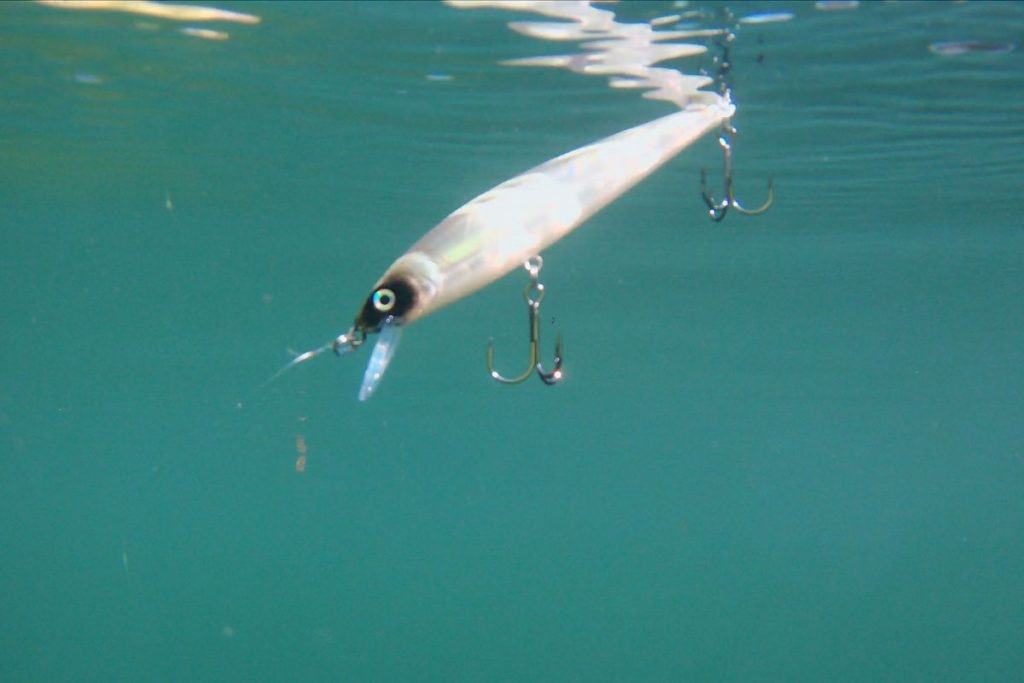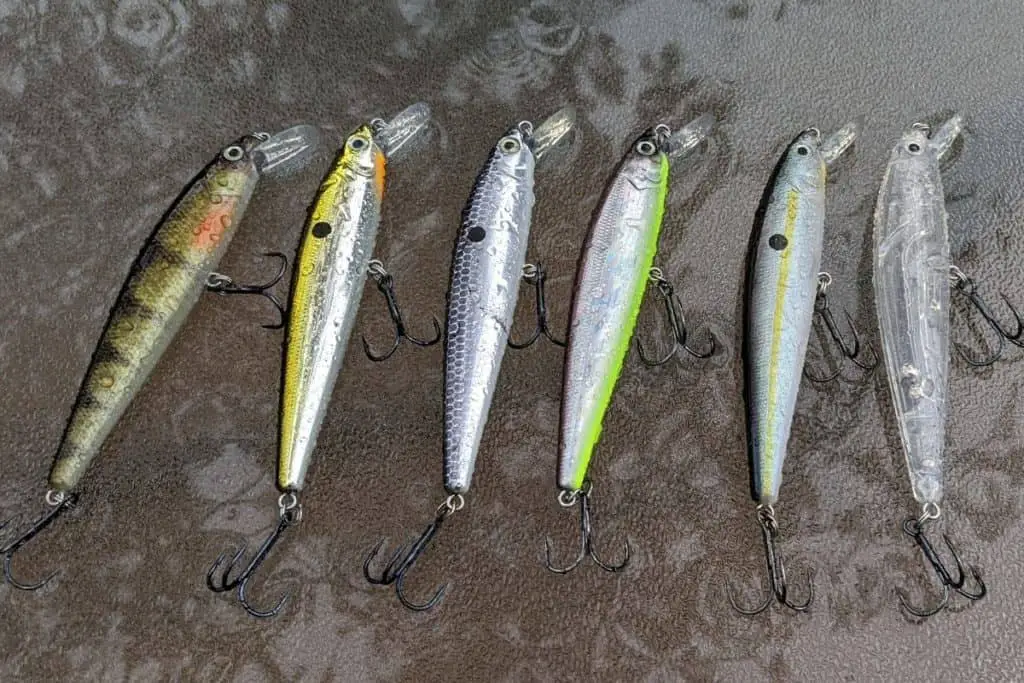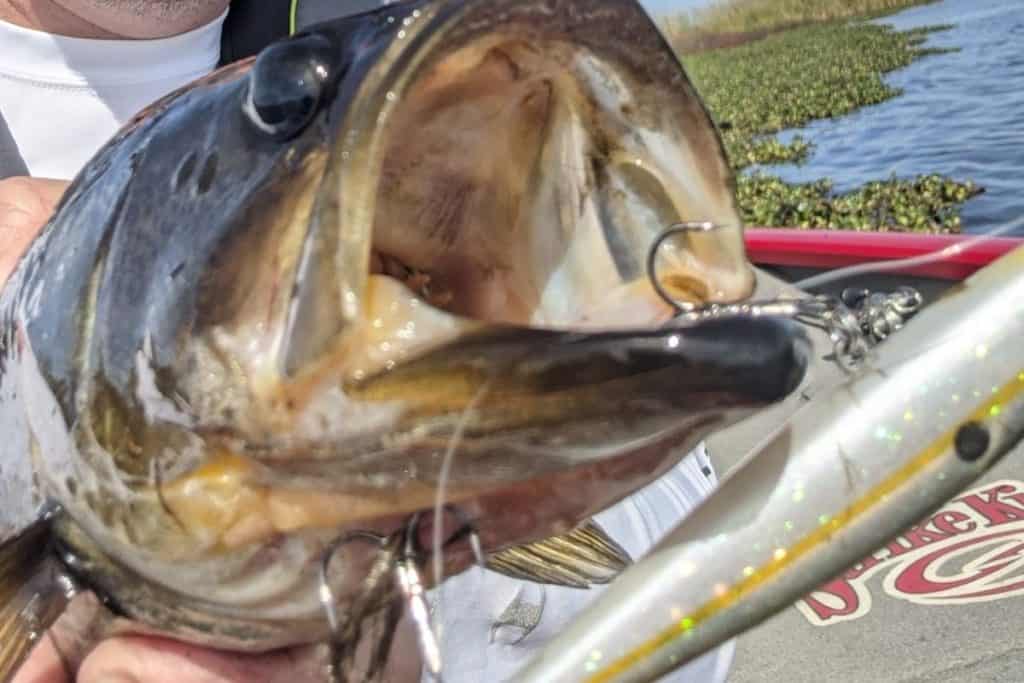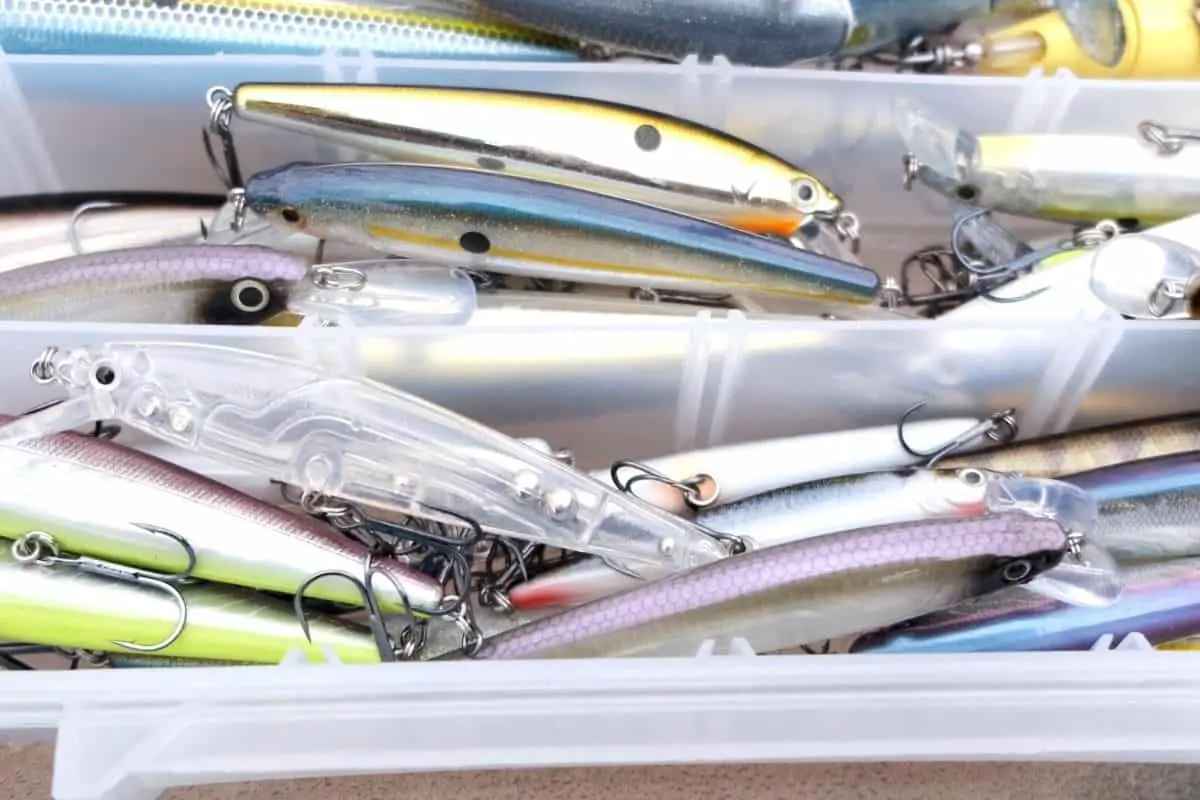Dedicated bass anglers that use jerkbaits often know that the lure may be the best reaction bait out there. Color choice can make this effective lure almost irresistible to bass.
Select shiny or translucent jerkbaits in clear water with sunny conditions. Natural colors work well on cloudy days and water with some stain. Dirtier water is best matched with solid colors.
The right jerkbait color can make a noticeable difference when looking for a great reaction bite.
Jerkbait Color Selection in Clear Water With Sunny Conditions
Bass that live in clear and ultra-clear water are very sight-oriented.
The darting action of a suspending jerkbait will get their attention. When they move in to attack the lure they will decide in an instant if it looks like something that is worth eating.
If the sun is really bright, I tend to select colors that will reflect that light. Chromes and silvers are excellent choices.

If the fish don’t quite commit to a solid, reflective surface I will then switch to a translucent color. I will even tie on a jerkbait that has no color at all and is clear.
I am such a huge fan of translucent jerkbaits that I have a tackle tray full of them.
There is something about the bass not getting a great look at the lure that helps more wary predators to commit and attack it.
(Here is an article on the best conditions for fishing a jerkbait.)
Cloudy Conditions or Slightly Stained Water
When the sun disappears or the water has some tint to it, I will then go right for jerkbaits that are more natural in the color patterns.
If there are shad in the places I fish, then muted silvers, whites, and grays get the job done. When panfish, such as bluegills, are the primary food source, then grabbing a few colors that imitate those offerings are a solid choice.
I have many jerkbaits that match both bluegills and perch.
These colors will also be good selections in clear and sunny conditions if the bass do not quite commit to the flashy colors mentioned earlier.

Dirtier Water Conditions and Jerkbait Color Selection
I should make it clear that I do not fish jerkbaits in muddy water conditions. When this type of water clarity is present, bass like to hold very tight to structure or the shoreline.
Other lures work better in those conditions.
But, if the water is really stained yet still has some visibility a jerkbait can and will get the job done.
Here is where I choose solid color patterns.
Solid white, solid gray, solid black, or solid chartreuse with a black back will get the nod.
In these conditions, the bass will first feel the lure ripping through the water and then use their eyesight when closer to it.
Without the clarity, the overall profile of the lure is more important than having the eye-popping detail used in clear water lures.
During underwater experiments in really stained or dirty water, I have found that white and white/chartreuse are by far the most visible.

How to Tell if Your Color Selection is Dialed In
This is a great question and an important one.
When I am fishing a jerkbait, my goal is to get the fish to eat it as deep as possible.
If the bass is just nipping and getting hooked on the back treble, then that is the clue for me to adjust colors.
The better the strike and the more of the hooks they get, I know that my color choice is getting closer to being dialed-in perfectly.
So often when we catch a bass we are so excited that sometimes the little details of how the fish is hooked slip our mind.
I have found time-and-time again that this has worked. I keep adjusting the color until the bass hit is solid and take it with authority – not nip at it.
Of course, there are days when they are lethargic and it seems they will only hit the back treble. If that is the case, I will alter my retrieve and cadence leaving the lure sit longer between rips.

The Most Important Aspect of Fishing a Suspending Jerkbait
If there is one mistake that I see often, it is anglers ripping a jerkbait on a taut line.
It is critically important to rip the lure on a slack line.
This makes the cut and slash at a much more extreme angle. Many jerkbaits on the market will actually side-to-side sashe a full 180 degrees.
A simple way to tell if you are ripping the lure on a slack line or not is to gauge how tired your arm is.
If your forearm is throbbing, then you are working too hard. When ripping on a slack line your arms will last much longer before getting fatigued.
Choosing the Jerkbait for the Proper Depth
When fishing jerkbaits, it is common to be fishing more open water and not around shoreline cover.
Fish may be still relating to the bottom, weedbeds, or even suspended.
Keeping the jerkbait at, or slightly above, the bass is important.
Having a variety of jerkbaits that reach multiple depths will help you dial in where the fish are at. For example, if the bass are sitting on a weedbed that is in 12 ft of water, using a lure that reaches only 3 or 4 feet will probably not draw them up. But a lure that is hitting the 10 ft mark would be perfect.
Many companies number their lures as 100, 200, 300, and 300 deep. Keeping a few of each model will get your jerkbait where it needs to be.
Tight lines. Be safe and make sure to encourage someone today. You never know how you may change their life forever.
What a Suspending Jerkbait Does so Well
In my opinion, there may not be a better reaction bait out there.
The extreme slashing and cutting action of a jerkbait drives bass crazy. The lure perfectly mimics baitfish that are actively avoiding a predator. When bass see this, they want in on the action too. Their natural instincts kick in.
If you have fished waters with a healthy smallmouth population then you may have noticed their inherent “wolf pack” behavior.
Other fish will do everything they can to get in on the frenzy and will even attempt to take the lure out of the mouth of the fish that has the bait.
Largemouth bass will act the same way, albeit not as extreme as smallmouth.
Isaiah 6:8

